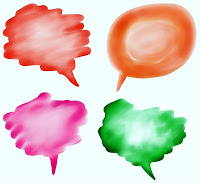Graphic novels often receive attention for their
motivational properties (e.g., Gavigan, 2010); however, a recent study by
Boerman-Cornell (2016) suggests graphic novels also promote “multimodal
critical discussion” and “[strengthen] multimodal comprehension” in elementary
students (p.333). The term multimodal
refers to the integration of more than one source of meaning (e.g., visual
representations, text, music, etc.) within the same material. Specific to text for example, fonts and type sizes are often used to convey meaning.
Graphic novels employ a variety of multimodal devices. These
include text embedded within images, “sound-effect words,” speech bubbles of
varying shapes and sizes and “speed lines” to name a few (Boerman-Cornell,
2016, p.328). The seamless integration of meaning-conveying techniques such as these make graphic novels a powerful tool for building comprehension. Boerman-Cornell
(2016) found that students working with graphic novels in grades 2-4 could:
- · Summarize modality
- · Understand multimodal humor
- · Articulate major themes and support claims with multimodal evidence
- · Critically discuss messages located in a variety of modal devices
Furthermore, sample students were able to make connections
across the text and to their own lives. Boerman-Cornell (2016) emphasized the
importance of utilizing graphic novels in the elementary classroom as a means
of better preparing students to more fully understand multimodal websites and
advertisements. He suggested that teachers 1) “encourage students to pay
attention to how the images and words work together” and 2) invite students to
“make connections to the text and images” (p.333).
Graphic novels recommended by Boerman-Cornell for students
in grades 2-4 include:
- 1. Bird and Squirrel on the Run by James Burks
- 2. Rapunzel’s Revenge by Ben Hatke
- 3. Roller Girl by Victoria Jamieson
- 4. Apollo: The Brilliant One by George O’Connor
- 5. Zita the Space Girl by Ben Hatke
Know of other fantastic titles? Share them with us in the comments section.
Boerman-Cornell, W. (2016). The intersection of words and
pictures: Second through fourth graders read graphic novels. Reading Teacher, 70(3), 327-335.
doi:10.1002/trtr.1525
Gavigan, K. W. (2010, January 1). Examining struggling male
adolescent readers' responses to graphic novels: A multiple case study of four,
eighth-grade males in a graphic novel book club. ProQuest LLC.


Comments
Post a Comment